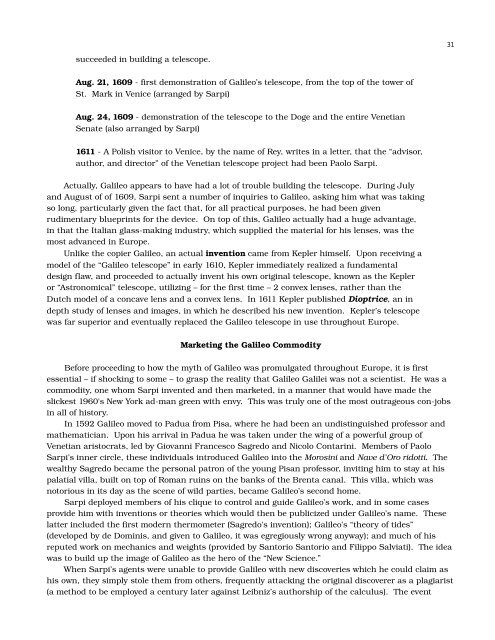Create successful ePaper yourself
Turn your PDF publications into a flip-book with our unique Google optimized e-Paper software.
31<br />
succeeded in building a telescope.<br />
Aug. 21, 1609 first demonstration of Galileo’s telescope, from the top of the tower of<br />
St. Mark in Venice (arranged by Sarpi)<br />
Aug. 24, 1609 demonstration of the telescope to the Doge and the entire Venetian<br />
Senate (also arranged by Sarpi)<br />
1611 A Polish visitor to Venice, by the name of Rey, writes in a letter, that the “advisor,<br />
author, and director” of the Venetian telescope project had been Paolo Sarpi.<br />
Actually, Galileo appears to have had a lot of trouble building the telescope. During July<br />
and August of of 1609, Sarpi sent a number of inquiries to Galileo, asking him what was taking<br />
so long, particularly given the fact that, for all practical purposes, he had been given<br />
rudimentary blueprints for the device. On top of this, Galileo actually had a huge advantage,<br />
in that the Italian glassmaking industry, which supplied the material for his lenses, was the<br />
most advanced in Europe.<br />
Unlike the copier Galileo, an actual invention came from Kepler himself. Upon receiving a<br />
model of the “Galileo telescope” in early 1610, Kepler immediately realized a fundamental<br />
design flaw, and proceeded to actually invent his own original telescope, known as the Kepler<br />
or “Astronomical” telescope, utilizing – for the first time – 2 convex lenses, rather than the<br />
<strong>Dutch</strong> model of a concave lens and a convex lens. In 1611 Kepler published Dioptrice, an in<br />
depth study of lenses and images, in which he described his new invention. Kepler’s telescope<br />
was far superior and eventually replaced the Galileo telescope in use throughout Europe.<br />
Marketing the Galileo Commodity<br />
Before proceeding to how the myth of Galileo was promulgated throughout Europe, it is first<br />
essential – if shocking to some – to grasp the reality that Galileo Galilei was not a scientist. He was a<br />
commodity, one whom Sarpi invented and then marketed, in a manner that would have made the<br />
slickest 1960's New York adman green with envy. This was truly one of the most outrageous conjobs<br />
in all of history.<br />
In 1592 Galileo moved to Padua from Pisa, where he had been an undistinguished professor and<br />
mathematician. Upon his arrival in Padua he was taken under the wing of a powerful group of<br />
Venetian aristocrats, led by Giovanni Francesco Sagredo and Nicolo Contarini. Members of Paolo<br />
Sarpi’s inner circle, these individuals introduced Galileo into the Morosini and Nave d’Oro ridotti. <strong>The</strong><br />
wealthy Sagredo became the personal patron of the young Pisan professor, inviting him to stay at his<br />
palatial villa, built on top of Roman ruins on the banks of the Brenta canal. This villa, which was<br />
notorious in its day as the scene of wild parties, became Galileo’s second home.<br />
Sarpi deployed members of his clique to control and guide Galileo’s work, and in some cases<br />
provide him with inventions or theories which would then be publicized under Galileo’s name. <strong>The</strong>se<br />
latter included the first modern thermometer (Sagredo's invention); Galileo’s “theory of tides”<br />
(developed by de Dominis, and given to Galileo, it was egregiously wrong anyway); and much of his<br />
reputed work on mechanics and weights (provided by Santorio Santorio and Filippo Salviati). <strong>The</strong> idea<br />
was to build up the image of Galileo as the hero of the “New Science.”<br />
When Sarpi’s agents were unable to provide Galileo with new discoveries which he could claim as<br />
his own, they simply stole them from others, frequently attacking the original discoverer as a plagiarist<br />
(a method to be employed a century later against Leibniz’s authorship of the calculus). <strong>The</strong> event

















